| FieldGuidetoQuilts.com |
 Jacob's Ladder
*** Jacob's Ladder
***
|
These blocks were designed for diagonal placement. It's rare to see one with the blocks set on point, which is to say that the lines were perpendicular to the bed. .
See also:
Jacob's Ladder
















Jacob's Ladder
 Jacob's Ladder
Jacob's LadderWebster, 1915
 Jacob's Ladder
Jacob's LadderFinley, 1929
"All Jacob's Ladder quilts are made in very light and very dark colors only," Finley wrote. "The fundamental idea of a 'Jacob's Ladder' is extreme contrast resulting in a series of dark 'ladders' running up and down the quilt or diagonally across."
It's a rare block that didn't appear first in some form in a Ladies Art Company catalog. In this case, the LAC published a similar block called Rocky Road to California as its #237 and another called The Railroad as its #207. Both have fillips that distinguish them from the classic block.
Jacob's Ladder first appeared, with a few differences in the seam placement, in Marie Webster's 1915 book Quilts: Their Story and How to Make Them. While Finley's version has no pieces larger than a small square, Webster's uses four larger half-square triangles. So we understand from Jinny Beyer; in fact, Webster's illustrations are so small that it's hard to see any seams at all.
For an entirely different Jacob's Ladder from Grandma Dexter, click here:
The Railroad
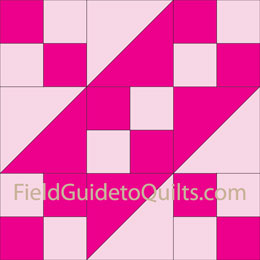















The Railroad
 The Railroad
The RailroadLadies Art Company #207, 1897 This Ladies Art Company block from 1897 (#207) varies from Jacob's Ladder only in the color placement in the lower left corner. The block has well over a dozen names, and we'll cite them if and when we can verify the seam placements.
Trail of the Covered Wagon
















Trail of the Covered Wagon
 Trail of the Covered Wagon
Trail of the Covered WagonKhin, 1988 Tail of Benjamin's Kite/Underground Railroad/Railroad
This block is one of many Jacob's Ladder variations that incorporate a double hourglass in their design (medium pink in the graphic at left). The block layout is from Yvonne Khin's Collector's Dictionary of Quilt Names & Patterns. The block would look much different if the medium and dark pink colors were reversed.
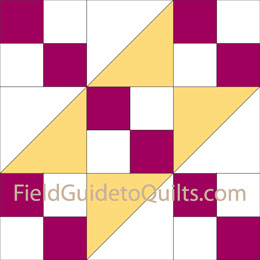 Jacob's Ladder
Jacob's LadderHavig, 1999 This Jacob's Ladder block in gold and brick red, from Havig's Carrie Hall Blocks, is identical to Trail of the Covered Wagon but for the choice of colors.
Rocky Road to California
 Rocky Road to California
Rocky Road to California Rocky Road to California
Rocky Road to CaliforniaLAC, #273, 1897 Rocky Road, the Ladies Art Company's #273, produces a unusual Jacob's Ladder variation with more emphasis on a secondary crossing line that runs from upper left to lower right in the mockup.
The block creates some interesting patterns. On the mockup, it looks almost as if the light squares are random, and the darker small squares disappear into the adjacent pieces. The progression of light half-square triangles (lower left to upper right) remind us of rows of curly ribbon.
We've followed the LAC's color placement exactly.
Road to the White House/The Broken Sugar Bowl
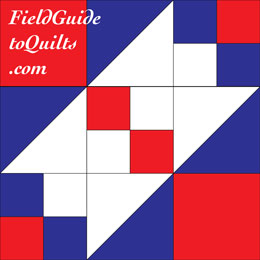















The Broken Sugar Bowl
Road to the White House
Farm Journal, 1938
 The Broken Sugar Bowl
The Broken Sugar BowlKCS, 1942Two other blocks are identical to Rocky Road to California except for the choice of colors: Road to the White House (Farm Journal, 1938) and The Broken Sugar Bowl (Kansas City Star, 1942).
The light-colored blocks on The Broken Sugar Bowl are supposed to be "figured" fabric. Otherwise, the mockups show them as nearly as possible to the originals.
Road to California
















Road to California
 Road to California
Road to CaliforniaKhin, 1988 We followed the original graphic color placement for both this block and Road to Arkansas, below. The version of Road to California at left is from The Perfect Patchwork Primer (Gutcheon/Davies, 1973), according to Yvonne Khin's Collector's Dictionary of Quilt Names and Patterns.
Road to Arkansas
 Road to Arkansas
Road to Arkansas
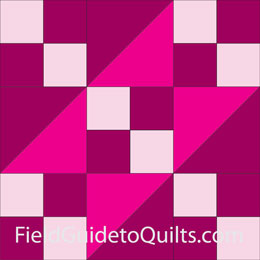 Road to Arkansas
Road to ArkansasHousehold Magazine, 1929 The block was first published as Road to California in The Household Magazine in 1929, according to Khin's Collector's Dictionary. After that, it appeared in a 1956 supplement to the Kansas City Star called the Weekly Star Farmer.
Sunny Lanes
 Sunny Lanes with offset blocks
Sunny Lanes with offset blocks
















Sunny Lanes
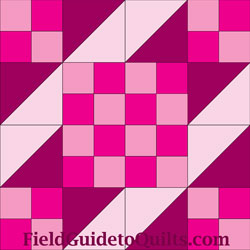 Sunny Lanes
Sunny LanesPage, 1935 Nancy Page's 1935 block is complex for a Jacob's Ladder-style block, since its 8 x 8 grid allows for a full 16-square checkerboard in its center.
Our colors are suggested by Brackman's Encyclopedia of Pieced Quilt Patterns.
We love the block name, but to us, the mockup looks a little weird. We tried offsetting the blocks by two squares. Result: It still looks weird.
The Underground Railroad















 The Underground Railroad
The Underground Railroad
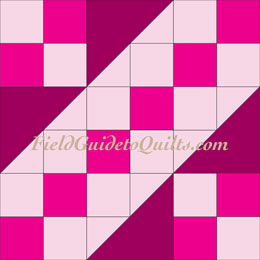 The Underground Railroad
The Underground RailroadFinley, 1929 Stepping Stones/The Tail of Benjamin's Kite/The Underground Railroad/The Trail of the Covered Wagon/Wagon Tracks
The names for this block, a three-color variation of Jacob's Ladder, are all Ruth Finley's, from her 1929 classic Old Patchwork Quilts.
Of those names, the Underground Railroad is the most memorable, particularly because of a controversy that flared up 70 years later with the book Hidden in Plain View.
The book laid out the oral history of the late Ozella McDaniel Williams of Charleston, South Carolina. In her family lore, quilt blocks provided route information and advice to escaped slaves on the Underground Railroad.
The escapees were supposed to take cues along the way to freedom by looking out for quilts folded to show a particular block and displayed outdoors. The "underground railroad" is a well-known term, first used in 1831, according to history.com. Quilt codes were a different category.
Ms. Williams was extremely cautious about telling the story to author Jacqueline Tobin. It took three years.
At first, Ms. Williams' hesitation itself lent credibility to the book, and the book's coauthor, Raymond Dobard, a professor from Howard University, championed the idea.
Since then, however, not a single historian, to our knowledge, has found any other shred of evidence of a quilt code in the antebellum South.
Nevertheless, the idea of a secret quilt code for the Underground Railroad was irresistible. Teachers still use it for projects because it gets children interested in history.
Meanwhile, furious academicians attack the story whenever someone retells it as if it were true. We'd argue that it is true; To the McDaniel family, it was as good as gospel.

